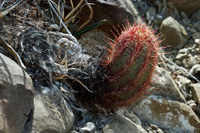Basionym: Echinocactus bolaensis Runge ('bolansis'), Gartenflora 38: 106 (1889).
Lectotype: Echinocactus bolaensis Runge ('bolansis'), Gartenflora 38: 106 (1889), E.F. Anderson, Bradleya 5: 59 (1987).
Synonyms: Echinocactus bicolor var. bolansis Schumann, Gesambt. Kakt. 303 (1898). Thelocactus bicolor var. bolansis Berger, Kakteen, 256 (1929). Ferocactus bicolor var. bolaensis N. P. Taylor, Cact. Succ. J. Gr. Brit. 41: 30 (1979).
Thelomastus bicolor bolansis Frič, in Kreuzinger, Verzeichnis 10 (1935), nom. illeg.
Echinocactus wagnerianus Berger, Kakteen, 256 (1929). Thelocactus wagnerianus Berger, Kakteen, 346 (1929). Thelocactus bicolor var. wagnerianus Krainz, Die Kakteen, Lfg. 18 (1961). Thelomastus bicolor Wagnerianus Frič, in Kreuzinger, Verzeichnis 10 (1935), nom. illeg.
Description
Stem single or clustering, ovoidal or cylindrical, 10-40 cm tall, 5-14 cm wide. Ribs 8-13, distinct. Tubercles rounded. Areoles with glands. Central spines 3-4, 15-35 mm long, white or ochre to reddish, straight, acicular. Radial spines 17-25, 10-25 mm long, white or ochre to reddish, straight, acicular. Flowers 60-80 mm wide, magenta with a red throat. Seeds 1.8 x 1.3 mm, testa cells convex with a verrucose surface sculpture.
Distribution
Mexico, Coahuila, occurring in matorral xerofilo on limestone or sandstone slopes or outcrops, at elevations of about 1000 to 1500 metres above sea level.
Risk assessment
Thelocactus bicolor ssp. bolaensis is placed in the category A (threatened) of the Norma Oficial Mexicana NOM-059-SEMARNAT-2010.
Comments
Bolaensis, with its dense and white spination, is a distinctive form coming from Sierra Bola in Coahuila, where it occures on limestone hills. Its characteristic spine colour is related to the soil type. In fact the plants growing on sandstone hills, present in the same area, show a coloured spination varying from straw-colour to bright red. These are referable to wagnerianus and can be found as far as Saltillo, to the east, where they intergrade with the typical bicolor. It is interesting to note that there exists a clinal variation affecting plant size and clustering capability. The plants growing around Saltillo have single, ovoidal stems, but as we move westwards the stem shape becomes elongate to short columnar while in the western part, at Sierra Bola or Sierra Zavaleta, large clumps of up to 50 heads can be found. This taxon is not widely accepted, but its differences from the type are as solid or as thin as those of flavidispinus or schwarzii, which are generally accepted at subspecies rank. The fact is that bicolor is a highly variable species.
Wagnerianus was described by Berger and should be differentiated from the type by its columnar stem, the reddish spines and the lack of flattened spines. Plants with these characters have been found west of Saltillo, Coahuila, where they intergrade eastwards with typical bicolor, while westwards their range extends as far as the area where the bolaensis form can be found. From a taxonomic point of view, actually there are not sufficient reasons to accept these forms at a formal rank.
Thelocactus bicolor ssp. bolaensis (Runge) Doweld, Sukkulenty 1: 30 (1999).
 The lectotype of Echinocactus bolaensis Runge
The lectotype of Echinocactus bolaensis Runge
From: Gartenflora 38: 106 (1889).
enlarge
 Thelocactus bicolor ssp. bolaensis
Thelocactus bicolor ssp. bolaensis
La Cuchilla, Coahuila
Photo: A. Mosco
enlarge
 Thelocactus bicolor ssp. bolaensis
Thelocactus bicolor ssp. bolaensis
Sierra Zavaleta, Coahuila
Photo: A. Mosco
enlarge
 Thelocactus bicolor ssp. bolaensis
Thelocactus bicolor ssp. bolaensis
Sierra Zavaleta, Coahuila
Photo: A. Mosco
enlarge
 Thelocactus bicolor ssp. bolaensis "wagnerianus"
Thelocactus bicolor ssp. bolaensis "wagnerianus"
Boquillas del Refugio, Coahuila
Photo: A. Mosco
enlarge
 Thelocactus bicolor ssp. bolaensis
Thelocactus bicolor ssp. bolaensis
Viesca, Coahuila
Photo: G. Hinton
enlarge